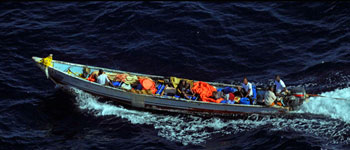
Many hail the efforts of the new Somali government to bring greater political stability to Somalia and hope that this will result in a crackdown on illegal activity in general, and piracy in particular. Yet October 2013 saw the resumption of pirate attacks in the Indian Ocean. So why doesn’t statebuilding help solve the issue of piracy?
In my work with Sarah Percy of the University of Western Australia and Federico Varese at Oxford, we found that political stability is a crucial element in the hijack-and-ransom piracy business model. To squeeze the maximum ransom from ship owners, pirates need to keep the ship safe and the crew in reasonable condition for periods of up to three years in territorial waters–effectively in plain sight of the coast. Ship owners would not pay up if rival gangs contested possession of ships during the negotiation or re-hijacked ships after their release. Based on the vessel tracks reconstructed from the signals sent by the ships’ automated information systems, we can see that the necessary security guarantees often cut across different clans’ territories.
But if anarchy reigns on land, then keeping the ships safe from rival gangs and supplying hostages and guards becomes difficult and expensive. Indeed, we saw that in the upheaval of 2006 when the Islamic Courts Union fought for control of the pirate anchorages in central Somalia, and piracy stopped dead for a number of months. When there is political stability, however, pirates can (and did) pay the incumbent political elites and their militias for safe anchorage and safe passage along the Somali coast. Political stability in the coastal regions is therefore helpful to pirates—as long as those providing governance on land are happy to shelter pirates.
So, Who Chooses to Harbor Pirates?
Federico Varese and I studied the geography of Somali piracy across space and time and noted the following patterns. Elites that had the option of profitably taxing regional trade flows and agricultural production always chose to do so. While there were sometimes attacks on local traders, fishing trawlers, and World Food Programme ships in southern Somalia, this is perfectly in line with military elites enforcing their system of taxation in their territory. What we did not find was foreign merchant ships being held for ransom in southern Somalia, even though political stability should have been sufficient: Islamist militias held Kismayo for many years.
Instead, hijacked merchant ships were taken to areas that were cut off from regional trade routes and where the mainstay of the economy was nomadic pastoralism–a notoriously difficult activity to tax. Interestingly, the same Islamist groups which promoted counter-piracy near southern Somalia’s major trade routes chose to tolerate piracy in central Somalia, showing that the choice to protect pirates is primarily an economic one. Hijack-for-ransom piracy intensified when there were political disputes over who would govern a particular territory; for example, overlapping territorial claims between Puntland and Galmuduq, or the desire to declare the Ras Aseyr region in Northern Puntland as an autonomous federal state.
How would we expect piracy to be affected by greater political stability in Somalia? Even if all territorial disputes in central Somalia were settled, without the development of a sustainable alternative tax base in the remote coastal regions, local elites would always be tempted to take criminal money. The example of Eyl in Puntland, where it is generally accepted that pirate money was channelled into the election campaign of Puntland’s President Abdirahman Farole, shows that electoral democracy may itself be a form of political instability that can promote criminality.
The Somali government and the international community have two options, and these are not mutually exclusive. One would be to greatly improve law-enforcement across Somalia so that local elites no longer have the choice to harbor pirates. The second would be to offer local elites a contract where the absence of piracy (and other forms of criminality) would be rewarded with development money and infrastructure spending, as promoted by the World Bank. This in turn would develop the local tax base.
As traders, mining companies, and fisheries tend to avoid crime-ridden territories and pirate-infested waters, economic development would mean that law-enforcement would eventually be in the local elites’ self-interest. An instructive example of a town that has worked hard to shake off its pirate image in response to a change in economic fortunes is Bosasso in northern Puntland. As soon as export bans on Somali cattle were lifted and Bosasso regained its status as a major export hub, the authorities began close co-operation with the international community on counter-piracy.
While political stability and electoral accountability in Somalia are to be welcomed for many reasons, we should not expect that it will solve the piracy problem. The international community needs to help the Somali government to incentivize local elites to deny safe anchorage to pirates, using the stick of law enforcement and the carrot of development money.
Anja Shortland is a Reader in Political Economy at Kings College, London.
A suspected pirate skiff 120 nautical miles east of Eyl, Somalia, February 2013. (EU Naval Force)




